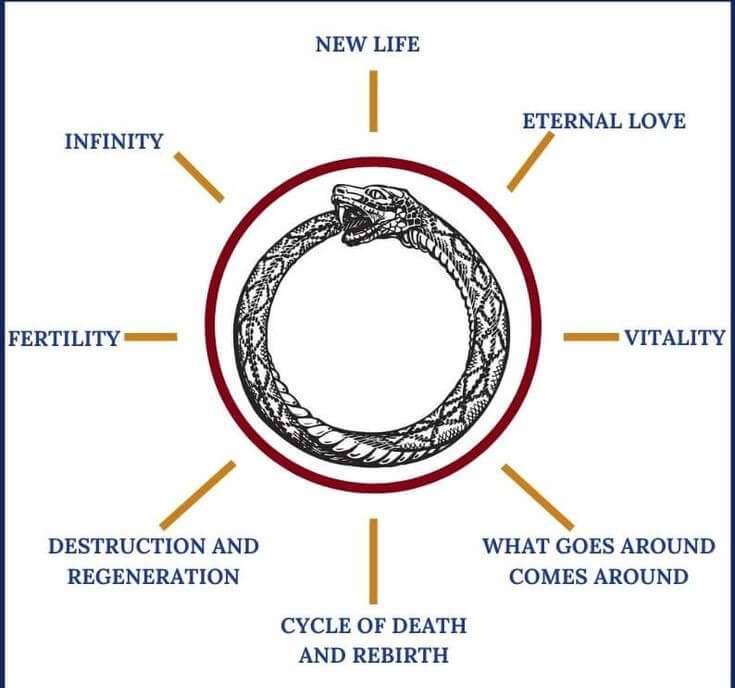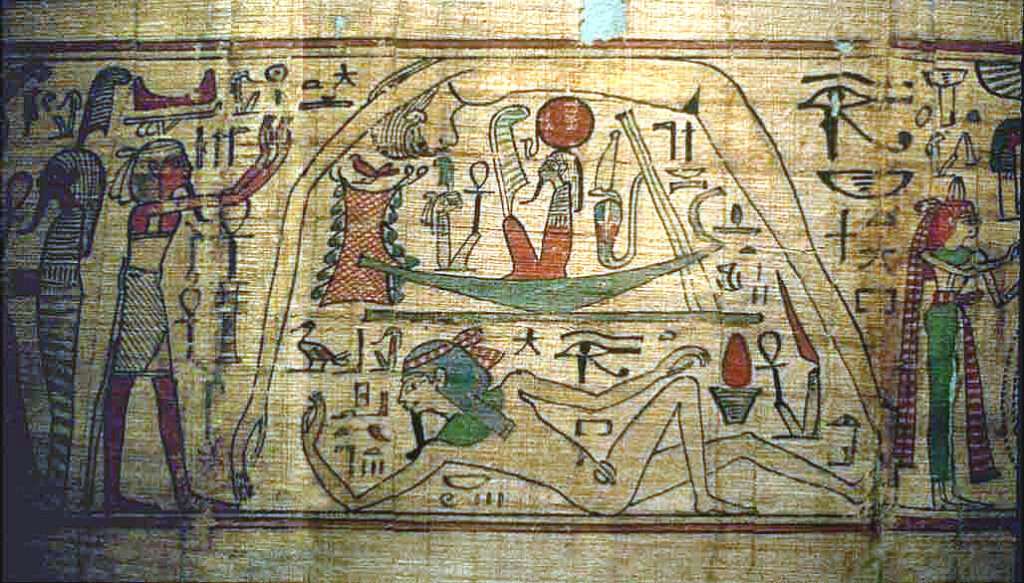Egyptian mythology, a captivating realm of stories and symbolism, has intrigued scholars and enthusiasts for centuries. At its core lies the Ouroboros, an ancient symbol of a serpent devouring its own tail, representing the eternal cycle of renewal and the universe’s timeless nature. Rooted deep in Egyptian lore, it symbolizes the unending cycles of life, death, and rebirth, reflecting the Egyptians’ profound reverence for life’s continuity and the afterlife. This article draws from extensive research, including academic texts and historical artifacts, to provide an accurate exploration of the Ouroboros in Egyptian mythology. With a focus on delivering original, well-researched content, it reveals the nuanced role and lasting impact of this symbol in one of the world’s most intriguing mythological traditions.
| HeadingEgyptian Ouroboros InformationOriginAncient Egyptian SymbolismSymbolismDepicts a serpent or dragon eating its own tail in a circular fashionSignificanceSymbol of cyclical renewal, eternity, and the eternal cycle of life, death, and rebirthUsageFound in Egyptian art and iconography, often associated with funerary and religious contextsMythological RoleRepresents the concept of the eternal and unending, linked to concepts of the afterlife |
|---|
1. Historical Context and Origin
The Ouroboros, an enigmatic symbol, holds a venerable position in the annals of Egyptian culture, its roots entwined with the earliest civilizations along the Nile. This symbol, a serpent devouring its own tail, emerged in Egyptian iconography as early as the 14th century BCE, with its first known representation in the funerary text, “The Enigmatic Book of the Netherworld,” found in the tomb of Tutankhamun. This circular serpent was not merely an artistic motif; it embodied the Egyptians’ deep-seated beliefs in regeneration, the cyclic nature of time, and the continuity of life and the afterlife.

In comparing the Egyptian Ouroboros to its counterparts in other ancient cultures, one observes intriguing parallels. For instance, in Greek mythology, the Ouroboros symbolizes the cyclical nature of life, akin to its Egyptian counterpart. Similarly, in Norse mythology, the serpent Jörmungandr encircling the world resonates with the idea of a cosmic cycle. These cross-cultural similarities underscore a universal recognition of the serpent as a symbol of eternity, a concept that transcends geographical and temporal boundaries.
2. Symbolism and Interpretation
In Egyptian mythology, the Ouroboros is a powerful symbol, encapsulating profound themes of eternity, cyclical renewal, and the intrinsic balance between life and death. This serpent, eternally consuming its own tail, is not merely a literal representation but a complex metaphor that delves into the core of Egyptian cosmology and theology.

At its most fundamental level, the Ouroboros symbolizes the unending cycle of life, death, and rebirth. This mirrors the Egyptians’ beliefs in the afterlife, where death was seen not as an end, but as a transition into a new phase of existence. The serpent’s continuous circular motion represents the endless cycle of the sun’s journey across the sky – a daily phenomenon that was central to Egyptian life and religion. This celestial cycle was synonymous with the idea of rebirth and regeneration, echoing the natural order of things where life springs from death.

Furthermore, the Ouroboros also encapsulates the concept of eternal life, a state of perpetual existence that was the ultimate goal of every Egyptian soul. In this regard, the Ouroboros is not just a symbol of the physical aspects of life and death, but also a representation of the spiritual journey of the soul seeking immortality.
3. The Ouroboros in Egyptian Religious Practices
The Ouroboros, far more than a mere symbol in ancient Egyptian culture, played a pivotal role in their religious practices and beliefs. Its depictions in religious artifacts and temples were not only artistic expressions but also significant elements in ritualistic ceremonies. The serpent, often encircling the sun god Ra, symbolized protection and the cyclical nature of the sun’s journey, which was central to Egyptian religious thought.
In religious ceremonies, the Egyptians often invoked the Ouroboros as a guardian entity. They believed that it encompassed the underworld and the afterlife, serving as a protective barrier. This representation of the Ouroboros as a guardian can be found in various Egyptian temples, where it frequently encircles the sanctum, symbolizing the eternal protection of the divine realm.

The connection of the Ouroboros to Egyptian gods and goddesses is profound. It is closely associated with several deities, including Atum, the god of creation and completion, and Osiris, the god of the afterlife, resurrection, and regeneration. These associations underscore the Ouroboros’s role in the concepts of creation, regeneration, and the eternal cycle of life and death.
In terms of its role in rituals, the Ouroboros was integral in ceremonies related to the afterlife and resurrection. The Egyptians believed that the journey of the soul after death mirrored the sun’s daily regeneration, a concept visually represented by the Ouroboros. This belief influenced various aspects of Egyptian burial practices, including the design of sarcophagi and the layout of tombs, where artists often depicted the Ouroboros as a symbol representing the deceased’s hoped-for rebirth and eternal life.
4. Ouroboros in Ancient Egyptian Art
The Ouroboros, a symbol steeped in mysticism and profundity, has left a lasting imprint on ancient Egyptian art and literature, transcending mere decorative purposes to convey deep spiritual and philosophical meanings. In art, the Ouroboros often appears in the form of jewelry, amulets, and in the ornate decorations of sarcophagi, symbolizing protection and the eternal cycle of life and death. Its circular form, embodying the concept of no beginning and no end, is a recurring motif in Egyptian murals and manuscripts, often surrounding or accompanying deities and pharaohs as a sign of divine protection and eternal life.
In Egyptian literature, particularly in funerary texts like the “Book of the Dead,” the Ouroboros appears as a guardian of the underworld, encapsulating the journey of the soul and the concept of rebirth. The texts often describe the Ouroboros in vivid detail, associating it with the sun god Ra, and emphasizing its role in the protection of the otherworldly realms and the regeneration of life.

Prominent artworks featuring the Ouroboros include the golden shrines of Tutankhamun, which depict the serpent encircling the horizon to symbolize the sun’s eternal cycle. Another significant representation appears in the “Alchemy Scroll” of Cleopatra, where the Ouroboros encircles a text to signify the unity and cyclicality of the cosmos and earthly matters.
These artistic and literary depictions of the Ouroboros have greatly influenced modern perceptions of the symbol. Today, it is often associated with the concepts of eternity, cyclical nature of time, and the idea of life springing from death. Its portrayal in ancient Egyptian culture has imbued it with a sense of mystique and profundity, making it a popular motif in modern literature, art, and psychology, often used to depict the idea of wholeness and the eternal cycle of life’s renewal.
5. The Ouroboros and Its Global Counterparts
The Ouroboros is not an isolated symbol in the realm of mythology; numerous cultures around the world incorporate it with unique interpretations while sharing common underlying themes.
In Greek mythology, the Ouroboros serves as a symbol of the eternal cycle of life and death, akin to its Egyptian counterpart, but it also holds ties to the alchemical tradition, where it symbolizes the concept of unity and the cyclical nature of the philosopher’s stone’s creation process. In Hinduism and Buddhism, the serpent or dragon biting its tail is seen as a symbol of time, continuity, and the cyclicality of existence. It also represents Kundalini energy in Hindu yogic traditions, signifying the unification of the divine feminine and masculine energies, leading to spiritual awakening.

A common theme across these cultures is the representation of the serpent or dragon as a symbol of eternity, continuity, and the cyclical nature of the cosmos. Despite the varied contexts and interpretations, these symbols reflect a universal understanding of life’s perpetuity and the interconnectedness of all things.
The differences in interpretation, from alchemical symbolism in the West to spiritual awakening in Eastern philosophies, demonstrate the flexibility of the Ouroboros as a symbol, adapting to different cultural beliefs and practices while retaining its core meaning of eternal cycles and renewal.
6. Conclusion
In summary, the Ouroboros is a symbol of profound significance in Egyptian mythology, encapsulating themes of eternity, renewal, and the cyclical nature of life and the universe. Its depiction in art, literature, and religious practices highlights its central role in ancient Egyptian culture, symbolizing protection, divine power, and the eternal journey of the soul. Comparative mythology reveals its universal appeal, with similar symbols found across various cultures, each adapting its core meaning to local beliefs and traditions. The enduring legacy of the Ouroboros, transcending time and geography, underscores its importance in our collective understanding of the world. It serves as a powerful reminder of humanity’s long-standing fascination with the mysteries of existence, and the value of such mythological symbols in connecting us to our past and enriching our understanding of the human experience.
